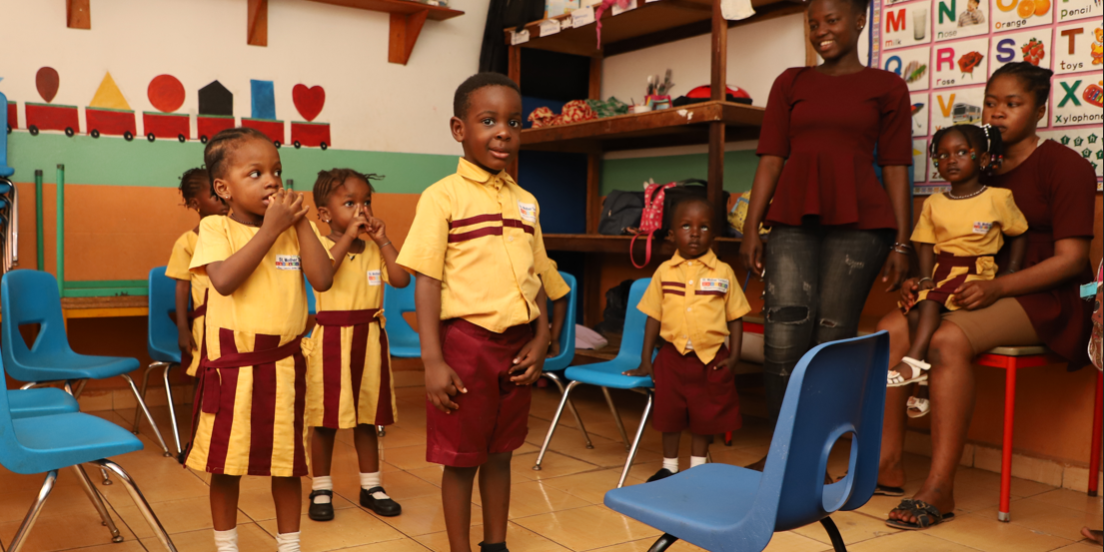Photo: Women teachers and children at the Mother Teresa Daycare Center in The Gambia. Credit: Haddija Jawara
Authors: Tanima Ahmed, Anne Hilger, Jason Weaver, Alieu Bah, Alpha Camara
Caroline has always had a passion for working with children and noticed that her country, The Gambia, lacks quality childcare. She believed that limited childcare could be hindering women from earning an income and children from realizing their potential, experiences shared by other countries like Burkina Faso, Mozambique, Nicaragua, Kenya, and Uganda. In the absence of quality guidelines or training courses on becoming a childcare provider in The Gambia, Caroline went abroad and learned by working in a daycare center in the United Kingdom. In 2021, she opened her own “St. Mother Teresa” Daycare Center, enrolling children aged 3 months to 4 years. It resembles the high-quality UK childcare center that Caroline worked at in everything but location.
Despite efforts of people like Caroline, many women in The Gambia have limited access to affordable, quality childcare. A recent rapid assessment of the Gambian childcare landscape by the World Bank based on a desk review and interviews with stakeholders such as ministries, young mothers, trainees and directors of technical institutes, and civil society organizations suggests that more and better-quality investments in childcare could improve outcomes for women, children, families, and businesses. The Gambia has a high fertility rate of 4.7 births per woman and a female labor force participation rate of 57%. The childcare sector provides the opportunity for women to own their own childcare businesses, like Caroline, and offers employment opportunities for women, who make up 89 percent of childcare employees in The Gambia. Quality childcare can enable women to participate fully in the workforce while supporting children’s development and school readiness.
While the government reports that the number of daycare centers has nearly quadrupled from 29 to 114 in the last ten years, existing childcare services are still extremely limited and primarily concentrated in urban areas. All daycare centers are privately owned and generally operated for profit, while informal childcare arrangements are more prominent in rural areas. Centers mostly accommodate children ages 6 months up to 4 years. In the absence of daycare centers, many mothers increasingly use one of the 1,497 publicly and privately owned Early Childhood Development (ECD) centers for temporary childcare, but by mandate, ECD centers are meant to focus on older children ages 3-6 and only provide half-day support.
One of the mothers working as a teacher in an ECD center states: “Mothers in the community sometimes bring their children to the ECD centers and beg to leave them for a while to take care of their other work. Often mothers appeal to enroll their child in the center when there is no space and even when the child is underage.”
In the review, the lower the fees charged by the daycare and the ECD centers, the more likely the caregivers had little to no education and no training in caregiving. These low-cost childcare settings do not follow any curriculum, do not provide children with ample learning materials and toys, and lack monitoring of child development. With limited space, these centers often have a large group of children per caregiver/teacher, decreasing attention on children’s developmental milestones. A recent World Bank study in The Gambia illustrates how low-quality childcare centers can be detrimental to children’s development, placing already disadvantaged children further behind. In comparison, centers like Caroline’s are of higher quality but with a monthly service charge of around 1800 GMD (~USD 35) out of reach of the average Gambian household, earning a per capita income of 39,754 GMD (USD 772).
Gambian mothers participating in this rapid qualitative assessment call for help to expand the accessibility and quality of childcare. These mothers highlight how mentally exhausting this is when they need to routinely juggle work or classes and their domestic and childcare responsibilities.
One of the instructors at a technical and vocational education and training institution who participated in the study underlines: “Childcare is a big constraint in The Gambia. The students who have classes from morning to evening bring their babies to the college. It’s hectic to take care of a child and attend classes. The babies sometimes cry, and mothers need to come out of their class to take care. Getting training is a big opportunity for Gambian mothers, so they are reluctant to drop out and take pain to complete the education, but sometimes they need to drop out because of the constraint.”
With new initiatives planned to address technical and vocational education and training, youth employment, and social safety net support, the government is exploring how it can expand availability, enhance quality standards and training, and increase affordability of childcare provision in The Gambia. These plans will help empower women, support children’s development, and foster economic growth in line with international evidence on how childcare builds human capital. Caroline’s “St. Mother Teresa” Daycare Center demonstrates the transformative potential of accessible, high-quality childcare, offering better outcomes for Gambian women and children alike.




